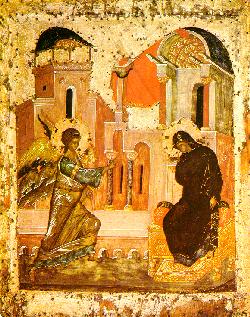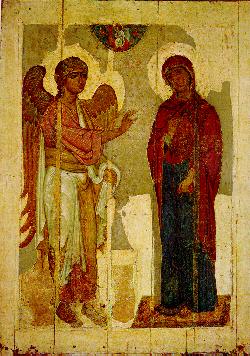
Moscow School, 14th century.
Tretyakov Gallery, Moscow, 43 x 34 cm.

This icon represents the Annunciation, that is, the moment when "The angel came in unto (Mary), and said, Hail, thou that art highly favored, the Lord is with thee, blessed art thou among women. And when she saw him, she was troubled at his saying, and cast in her mind what manner of salutation this should be. And the angel said unto her, Fear not, Mary: for thou hast found favor with God. And, behold, thou shalt conceive in thy womb, and bring forth a son, and shalt call his name JESUS." (KJV, Luke 1: 28-31).
In fact, Mary's clothing seems to correspond to the dark colors found in the roofs above her and in the angel, helping to unite foreground and background. The angel's coloring is unique in the painting and emphasizes its heavenly nature and function as one who announces the will of God to the world. The Annunciation theme had been well established in icon painting and could be traced, like many other themes, to the traditional Byzantine prototypes. One of the most admired icons of this type, The Annunciation of Ustyug (Novgorod, 1110-30, shown on the right) demonstrates how closely the early Russian icons preserved the Byzantine heritage, while infusing it with a new Russian style. In this Annunciation
the composition is more monumental than in its 14th century Muscovite version.
The Angel and Mary are strong, uncompromising figures who seem to speak directly
to the viewer; here the impact is immediate and
forceful. While the figures may lack some of the later icon's movement, they
are, nevertheless, equally impressive in their monumentality and spirituality.
The angel seems to resemble ancient statues, and its facial features, hair, and
the flowing garments make us think of classical antiquity. [B.B.] [Source: David and Tamara Talbot Rice].
In this painting the artist faithfully expresses the emotion and importance of the Annunciation scene. The angel occupies the left half of the picture plane, Mary occupies the right, and both stand out against the background constructed of architectural details connected in the middle of the picture. In contrast to the rather flat, forward–facing figures found in some icons, the announcing angel is shown from a side view which emphasizes depth and dynamic movement. The flow of drapery and the position of the wings reflect the fact that the angel has suddenly appeared and help strengthen the contrast with Mary, who is shown in a fixed and motionless pose. The beautiful gold and blue-green of the angel also emphasizes its heavenly origin and is balanced by the dark clothing worn by Mary, a representative of earth and humankind. While the angel's hand is outstretched as
the messenger speaks God's message, Mary's head is bowed as if in agreement and humility. Both figures are well-proportioned and accurately express the content of the scene. The overall color scheme of the background consists of a combination of yellow, cream, shades of orange, and black, which gives the icon a warm tone. The two figures in the foreground stand out against the surrounding colors, but do not clash
with them.
